For “Think Square 3: Virtual + In-Person Art Exhibit” at the Cincinnati Learning Collaborative, 60 artists contributed 5” x 5” pieces, all presented in 12” x 12” frames, and all for sale for the “low, low price” of $100. Kate Staiger and Andrea Knarr organized the show.
With a wide range of subjects, materials, and handling, the exhibit actually has something for everyone.
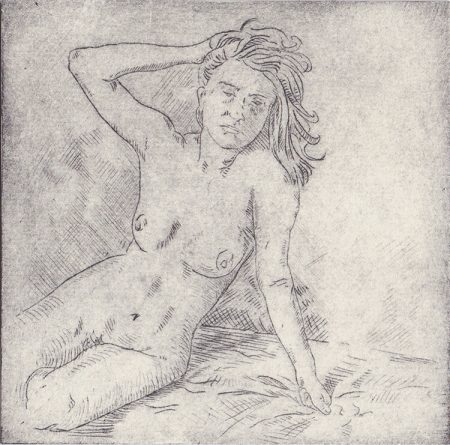
That was made abundantly clear on the Saturday afternoon I visited. A group of, not quite sure how to describe them. Artists? Collectors? Art aficionados? Or some hyphenate?
Whatever. They were certainly friends of Staiger, who provided the space for the exhibition and was on hand on the Saturday I visited. The visitors carried on a lively discussion on this, that, and the other thing, and were not shy about voicing their preferences among the artworks. I don’t think any of their choices jibbed with mine, and I wasn’t particularly drawn to pieces that had already sold. As I’ve already said, it all adds up to having something for everyone,.
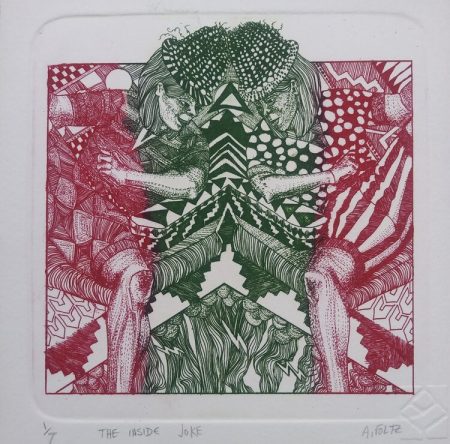
Amy Foltz, “Inside Joke”, intaglio
Within the parameters of the exhibition, there was a wide range of mediums: monotype, drypoint, woodcut, intaglio, risograph, and linocut; oil, acrylic, pastel, encaustic, and watercolor; assemblage, collage, and mixed mediums; glass, ceramic, fiber, embroidery; and photography.
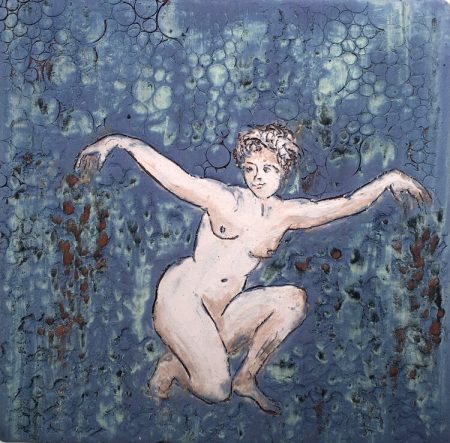
Marsha Karagheusian, “Flora”, ceramic
Artists took on subjects as varied as architecture, landscape, the figure (human, animal, and several appealing birds), and flowers. They used styles as disparate as realism, impressionism, expressionism, abstraction, and combinations of them.
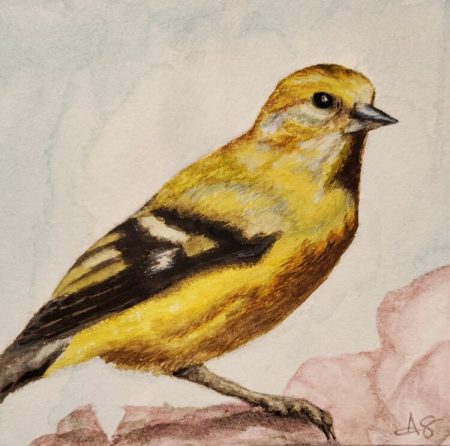
Alison Shepard-Hildenbrandt, “Golden Lady”, watercolor
Nothing was particularly experimental, but I found the tendency toward the traditional comforting in the age of the coronavirus.
Each category of motifs illustrates the diversity of artistic interpretations possible. For example, let’s look at trees.
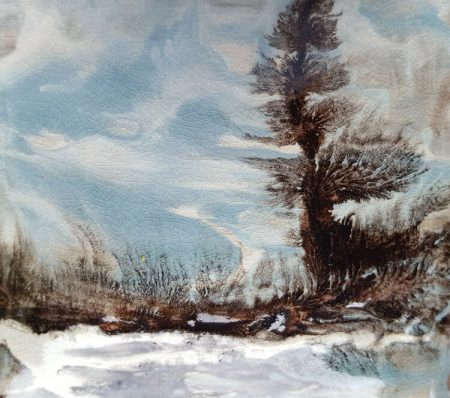
Cheryl Pannabecker, “Winter”, ceramic with colored slips and glaze
Cheryl Pannabecker’s Winter, a pillow-like ceramic plaque decorated with colored slips and glaze, is an expressionistic windswept scene with the cirrus sky echoed in the snowdrifts. A tall tree bends to the will of the wind.

Bryn Weller, “Untitled”, photograph
The tree in Bryn Weller’s Untitled photograph stands strong. Weller’s shot it from beneath, and the thick trunk rushes upward, piercing a canopy of branches and leaves that are filtering the light, and continuing upward to reach the sky. The photo is a “reproduction” of reality, once removed from the world.
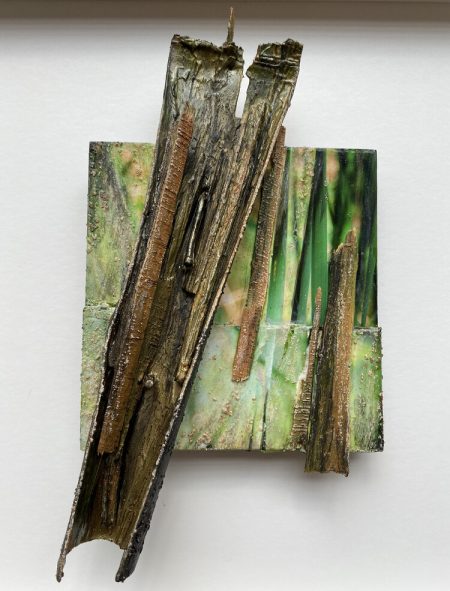
Joell Angel-Chumbley, “The Grove”, mixed mediums
Another interpretation of realism is found in Joell Angel-Chumbley’s The Grove. It’s an assemblage of strips of bark nailed over or affixed to a partially painted over photograph of green shoots. The bark she uses is not an interpretation but what is found in the real world.
Flowers also inspired diverse aesthetic approaches.
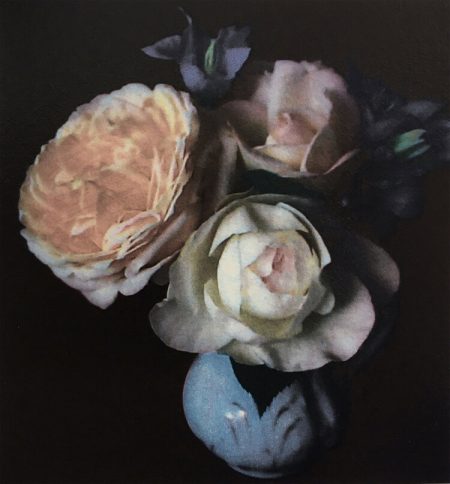
Rick Finn, “My Mother’s Vase (my flowers)”, gum bichromate over platinum/palladium print
Rick Finn’s My Mother’s Vase (my flowers) is one of the sexiest pieces in the show. He’s zoomed in on three overblown roses, each facing a different direction, crowded into a bulbous vase. It’s a gum bichromate over platinum/palladium photograph, a technique embraced by Pictorialists at the beginning of the 20th century. Their aim was to create painterly effects in a bid to have the medium accepted as a fine art. How different would we react to this set-up if it were an unmanipulated photo? The technique lends an air of the romantic to the still life.

Ursula Roma, “Flower Matrix”, acrylic on paper
Ursula Roma goes in a completely different direction with her sprightly stylized daisies sprouting all over a ground of coral and scarlet.

Chris Plummer, “Untitled (Queen Anne)”, Styrofoam woodcut
Chris Plummer’s silhouetted stalks of Queen Anne’s lace stand in the foreground to block entry to the expansive fields beyond or, alternatively, show the way to them. The use of color and flatness of the compositional elements evoke the late 19th-century Nabis.

A languid female leans back in a chair. She’s not in a conventional office; instead she’s brought her chair outdoors, placing it in the middle of a riotous garden with oversized poppies and purple irises that flit around like butterflies. With a dreamy gaze, she’s turned to face the viewer. Her thick hair and pose reminded me of the Pre-Raphaelite Brotherhood of the 19th century. But she’s our contemporary as she sits with her laptop, working from “home.”
I mentioned the breadth of techniques and mediums used by artists earlier, but I want to pull out some specific examples.

Anne Straus, “Moon Goddess”, textile
Anne Straus’s embroidered Moon Goddess took me back to the ’70s when women artists were embracing feminist themes and using techniques deemed women’s work. Think Miriam Shapiro, Judy Chicago, Anne Wilson, etc. Straus’s Goddesses are inspired by Neolithic goddess sculptures from 4000 BC, which were found in Eastern Europe. Embroidered with metallic thread, it is a sacred treasure.

Sandra Gross, “Butterfly”, fused glass
Glass possesses qualities that can’t be duplicated in any other material. Sandra Gross has fused flat glass shapes into a luminous Butterfly where the color seems suspended in air. Glass captures the delicate nature of the creature.
The exhibition closes on October 31, but is also online at cincilearncollab.org/think-square-3. We have all gotten used to ordering online, so why not art? Collectors have been buying pieces they have only seen as slides for a long time. Now it’s the computer screen.
The pieces in this show can be purchased “remotely.” Check the website–cincilearncollab.org–and click on “Enter” to access images of all the artworks in “Think Square 3: Virtual and in-Person Art Exhibit.” Pieces that are sold are marked, but there are some works that are still available. Not ideal, but we don’t live in an ideal world.
–Karen S. Chambers
“Think Square 3: Virtual + In-Person Art Exhibit,” Cincinnati Learning Collaborative, 2813 Woodburn Ave., Cincinnati, OH 45206, 513-470-7400, cincilearncollab.org, kate@ cincilearncollab.org. Call for hours. Through October 31, 2020



